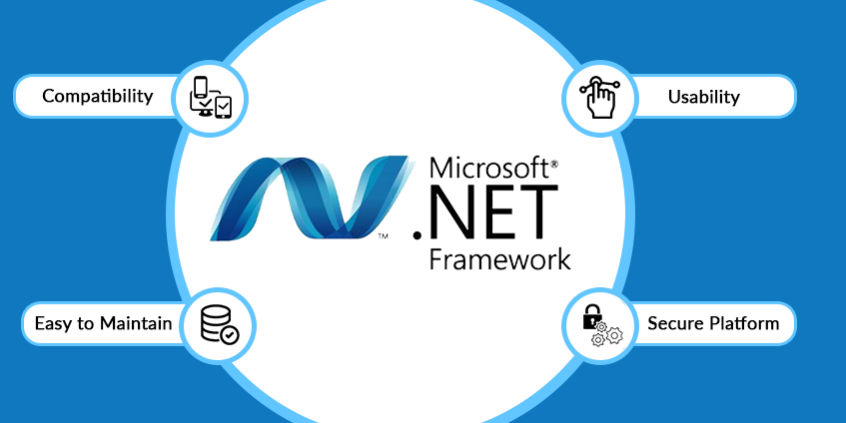The .NET Framework is a programming model that supports building and running of programming applications for Windows, Windows Server, Windows Phone, Microsoft Azure, and XML Web administrations. It is created by Microsoft and runs on Microsoft Windows. The .NET Framework comprises of an enormous class library known as Framework Class Library (FCL), and Common Language Runtime (CLR) which gives language interoperability across a few programming dialects.
This system was composed to defeat large numbers of the issues of utilization advancement including long improvement times, powerlessness to change applications rapidly, high absolute expense of responsibility for and simplicity of arrangement.
Highlights of Common Language Runtime (CLR):
- Oversees memory, execution of strings and code, check of code security, aggregation, and other framework administrations
- Executes code access security
- Guarantees code power through an exacting kind and-code-check foundation called the normal sort framework (CTS).
- Without a moment to spare (JIT) aggregating empowers all oversaw code to run in the local machine language of the framework on which it is executing and memory administrator eliminates conceivable outcomes of divided memory and expands memory region of-reference which improves execution.
- Runtime can be facilitated by worker side applications, like Microsoft SQL Server and Internet Information Services (IIS) that are high on execution
Highlights of Framework Class Library (FCL):
- Incorporates a bunch of standard class libraries. These class libraries execute regular capacities, like realistic delivering, information base communication, and XML record control, among others.
- Assortment of reusable kinds that are firmly coordinated with the CLR.
- Article situated class library which intends to achieve a scope of basic programming undertakings, like string the executives, information assortment, data set availability, and document access
Benefits of .NET for Business Application Development
The achievement or disappointment of any task or item in the market is chosen by its profit from speculation. Both the quantum of benefits and time taken are significant parts of computing ROI. The accompanying highlights of .NET encourage decrease of formative and operational expense for an effective IT association.
Less Coding and Increased Reuse of Code:
This structure chips away at object-arranged programming which wipes out pointless codes and includes less coding for the designers. .NET comprises of re-useable code and numerous re-useable parts. This converts into less time and thus less expense to create applications.
Arrangement:
With highlights like no-sway applications, private segments, controlled code sharing, one next to the other forming and somewhat confided in code, the .NET system makes organization simpler post turn of events. The code execution climate upholds safe code execution for decreased clashes in programming arrangement and forming, and limited execution issues of scripted or deciphered conditions.
Dependability:
Since its delivery in 2002, .NET has been utilized to create a large number of utilizations. Its presentation on Microsoft® Windows Server™ 2003 and Windows 2000 Server is likewise truly steady and solid.
Security:
.NET offers upgraded application security as web applications created utilizing ASP. NET have Windows affirmation and setup. Overseen code and CLR offer defend highlights, for example, job based security and code access security.
Use across Platforms and Languages:
. NET permits engineers to create applications for a work area, a program, a portable program (like on your PDA), or an application running on PDA. .NET is advanced as a language-free system, which infers that improvement can happen in various agreeable dialects that incorporate C#, oversaw C++, VB.NET, Visual COBOL, IronPython, IronRuby and the sky is the limit from there.
Use for Service-Oriented Architecture:
.NET is frequently utilized for Web Services, which are an answer for executing a SOA technique. Through Web Services, applications which are planned in various programming dialects or stages, can impart and communicate information using standard Internet conventions.
Combination with Legacy Systems:
The ability of .NET to handle a wide range of XML reports and compose any configuration of document without any difficulty, gives various courses to mix.
Sorts of utilizations that can be made with .NET
- Work area applications that include:
- Windows GUI application or Windows Forms (or Winforms) applications
- Bookkeeping applications
- Item/stock applications
- Warehousing applications utilizing hand-held gadgets
- Applications for esteem chain/supply the executives
- Windows administrations applications
- Online applications including:
- Sites
- XML Web administrations
- Applications requiring joining with accomplices through the Internet
- Applications on installed frameworks like:
- PDA (hand-held) applications
- Applications for mobiles
- Others including:
- Windows Presentation Foundation (WPF) applications
- Reassure based applications
- Administration situated applications utilizing Windows Communication Foundation (WCF)
- Work process empowered applications utilizing Windows Workflow Foundation (WF)
- ASP.NET applications








